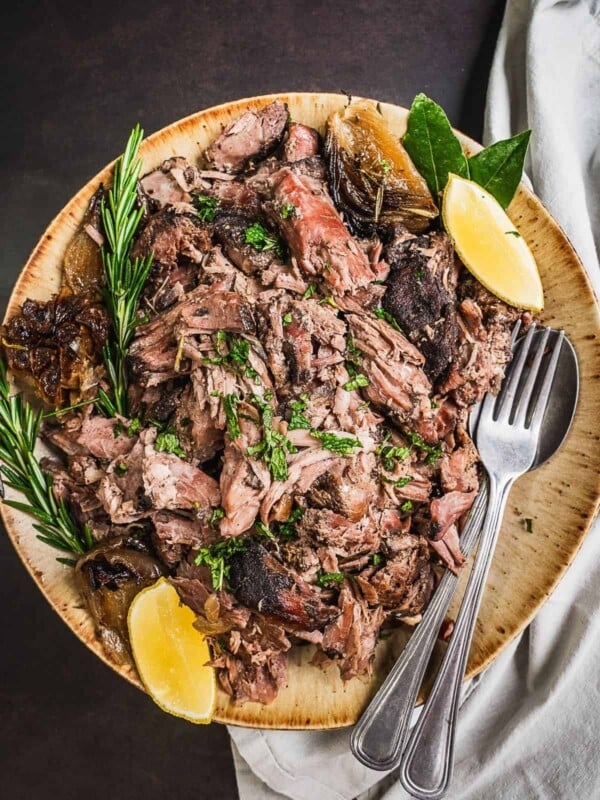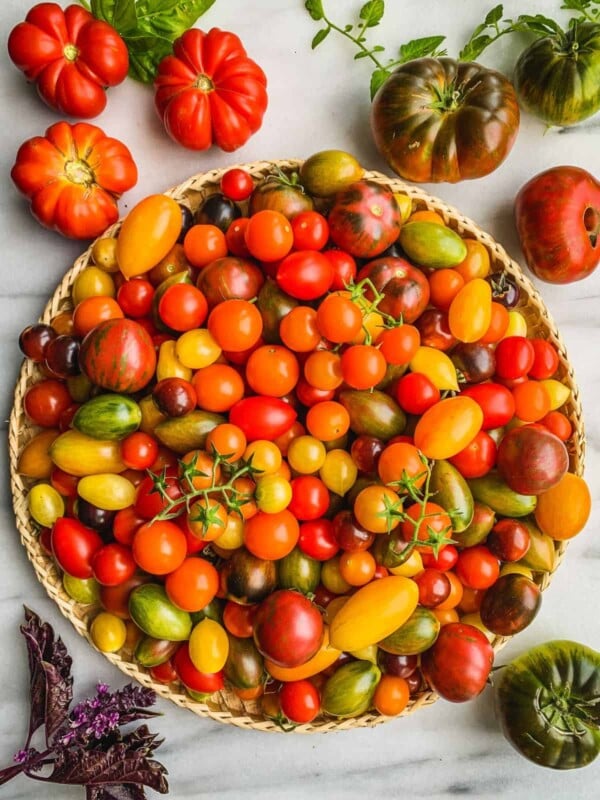Thyme (Thymus vulgaris) is a popular herb in the mint family that is commonly used in cooking and has a number of potential health benefits. It is a useful and flavorful herb that is used in braising, roasting, marinades, salad dressing and more.
This post covers everything you need to know about this timeless herb including different varieties, culinary uses, growing, storing, preserving, substitutions and recipes.

Table of Contents
History
Thyme is native to the Mediterranean region and has been used for culinary and medicinal purposes for centuries. It is a small, woody plant that grows to be about 6”-12” (15-30 cm) tall and has small, gray-green leaves and delicate purple flowers.
Culinary uses
Thyme is a versatile herb that can be used in a wide range of dishes, including soups, stews, marinades, compound butter, and sauces. It pairs well with a variety of other ingredients, including vegetables, eggs, meats, and grains. It is used in roasting and braising. Thyme is also a common ingredient in herb blends such as bouquet garni and herbes de Provence. It pairs well with other hebs like parsley and basil.
Varieties
There are many varieties of thyme. Here are a few that I enjoy and think you will too.
- Common Thyme (T. vulgaris): A standard variety, as the name suggests, that’s a good all-around option for any garden.
- Lemon Thyme (T. x. citriodorus): A lemon scented thyme variety with beautiful yellow and green foliage. An excellent choice for marinades.
- Creeping Thyme (T. praecox): used as ground cover, this hardy variety can also be consumed. I prefer to grow it as ground cover.

Other uses
In addition to its culinary uses, thyme is also sometimes used in cosmetics and perfumes. It is believed to have soothing and toning properties and is often used in products for the skin and hair.
High-Level Nutritional Information
There are several potential health benefits associated with thyme. It is a rich source of antioxidants. Thyme is also a good source of iron and other essential minerals, and it has been traditionally used to help alleviate respiratory issues such as coughs and bronchitis.
In addition, some studies have suggested that thyme may have antimicrobial properties and may be effective against certain types of bacteria and fungi. As always, for specific nutritional information or for dietary advice, please consult a licensed dietician or nutritional specialist.
How to Grow
Thyme grows best in well-draining soil in a sunny location. It is a hardy plant that is drought-resistant and can tolerate a wide range of temperatures. To grow thyme, it is best to start with a seedling or young plant, rather than trying to grow it from seeds. Once established, thyme is a low-maintenance plant that requires minimal care.

Thyme is a perennial and will come back year after year. It is an excellent herb to include in your perennial herb patch. It grows well in containers as well making it an easy herb to grow on terraces and balconies.
I personally grow it in the ground, in raised bed gardens, and in container gardens.
The best way to harvest is by snipping right above a leaf node. This allows the plants to bush out by sending out two few branches.
Culinary Substitutions
If you don’t have thyme on hand or are looking for a suitable substitute, some other herbs that have a similar flavor profile include oregano, marjoram, and savory. However, it’s important to keep in mind that these herbs may not be a perfect substitute and may alter the overall flavor of the dish.
How to Store and Preserve
If you’re growing thyme in your garden or on your windowsill, I suggest only harvesting what you need for a given recipe. But if you need to harvest it in large quantities or if you buy a bundle from the store, here are some storage options that will help keep it fresh the longest.
- Treat it like you would fresh flowers. Place stems upright in a mason jar with water. Thyme placed in water this way can last for a few days on the counter.
- If you purchase thyme in a clamshell container, it is best not to mess with it too much. The leaves are tender. If the leaves bruise, they may oxidize and turn brown.
- To store thyme for more than a few days, it is best to wrap it in a damp paper towel and place it in a plastic bag in the refrigerator.

How to Preserve
Basil can be preserved for long-term storage in several ways.
- Drying: This is my preferred method. You can certainly dehydrate it using a dehydrator. Once dried, thyme can be stored in an airtight container in a cool, dry place for several months.
- Compound butter: Freezing fresh chopped thyme in butter is a wonderful way to preserve it. Use pats of compound butter on grilled vegetables, steaks, and more.
- Frozen cubes: Freezing cubes of thyme in olive oil is a wonderful way to lock in its freshness for months to come. I like to use silicone ice cube trays filled to the brim with freshly chopped herbs and covered with olive oil. Once frozen, I transfer the frozen cubes to a reusable freezer bag. The cubes can be used to swirl into soups, and added to marinades all winter long.
Recipes that Feature Thyme
Levantine Recipes
Preservation
Main Dishes
Main Dishes
If you have any questions, please take a moment to leave a comment below. It’s such a help to others who want to try the recipe. For more Urban Farm and Kitchen, follow along on Instagram, Facebook, and Pinterest, visit the Urban Farm Shop, or subscribe for new posts via email.
.















